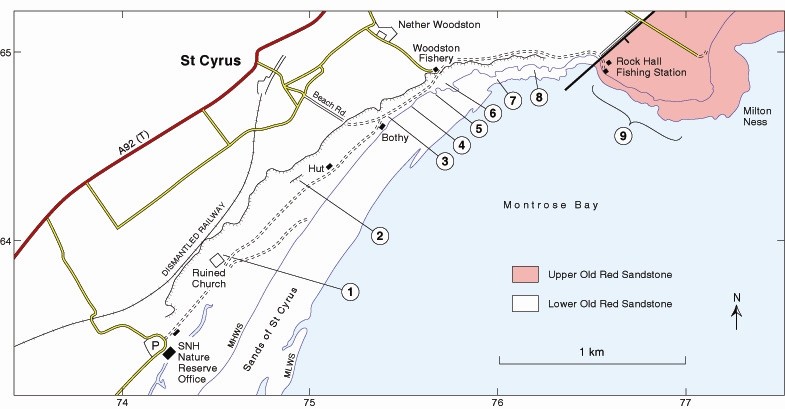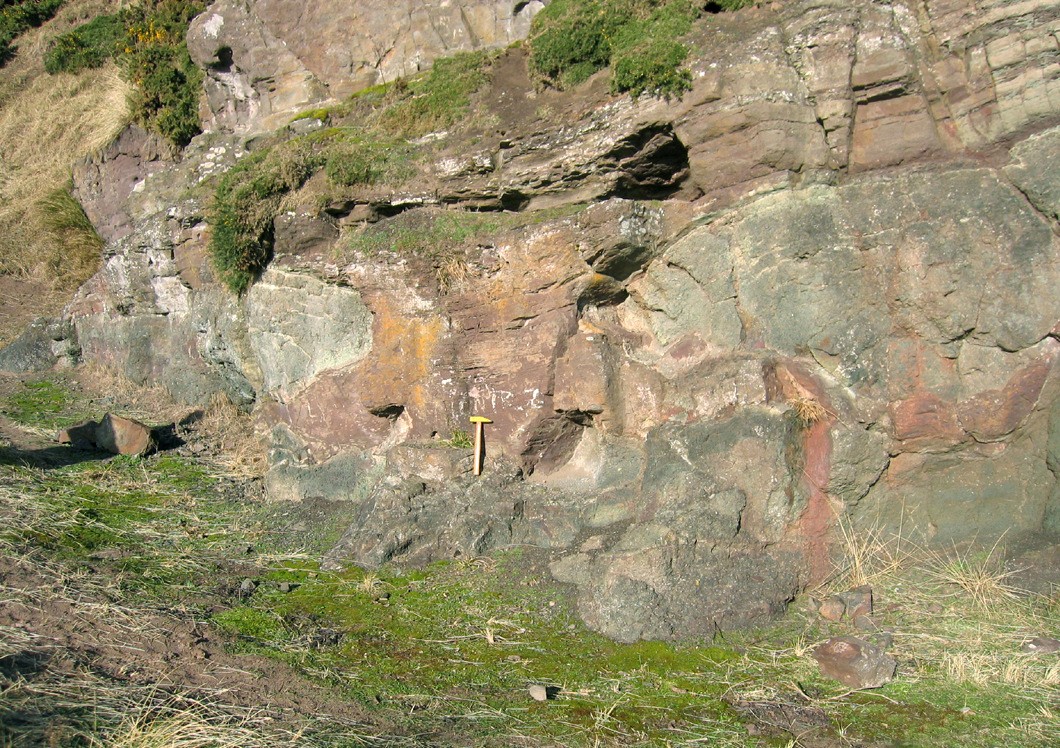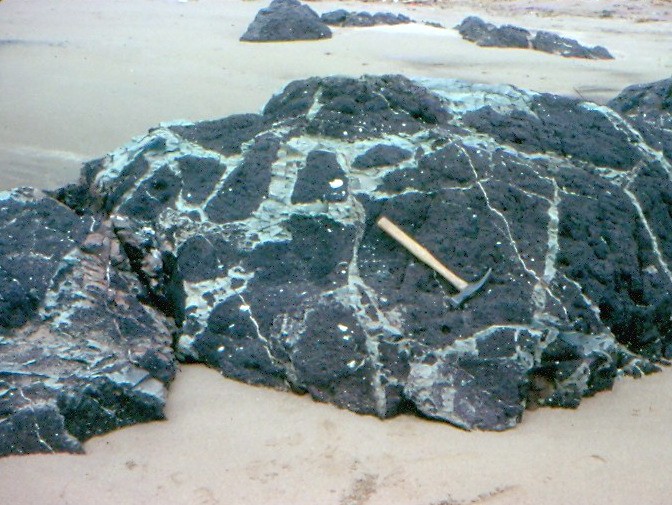Show interactive timeline
Devonian of St. Cyrus and Milton Ness
N.H. Trewin
An illustrated PDF download is available from the Aberdeen Geological Society website
Purpose
This short excursion covers some of the sediment/lava relationships seen in the Lower Old Red Sandstone at St. Cyrus beach, and the cyclic fluvial deposits of the Upper Old Red Sandstone of Milton Ness. This excursion can be conveniently combined with visits to Crawton (Exc. 22) or Dunnottar to Stonehaven and the Highland Boundary Fault (Exc. 23).
Access
Much of the area described is part of a National Nature Reserve, noted for the most northerly occurrence of a number of plants and insects. Collecting and hammering of rocks is not permitted within the reserve and visits to the rock falls on the cliffs are not allowed when birds are nesting and discouraged at other times; permission must be obtained from the Warden to visit the high cliff areas. The main features of interest are best seen on the shore exposures and half to low tide is advised.
From the A92 about half a mile (1 km) south of St. Cyrus a narrow unsignposted minor road (passing places and sharp bend; not suitable for coaches or minibus) branches off at
Introduction
The lavas and associated sediments exposed on the shore and the old cliff line form part of the St. Cyrus Lavas within the Arbuthnott Group of the Lower Old Red Sandstone. In the Strathmore region the Lower ORS consists mainly of conglomerates and sandstones deposited by rivers on alluvial fans and plains. Fossils of primitive land plants, which colonised low-lying wet areas, and of fish and arthropods from temporary lakes and streams have been found in the Arbuthnott Group. Extensive volcanicity occurred at a number of centres during the deposition of the Lower ORS and the lava flows exposed at St. Cyrus appear to have lain on the northern flank of the Montrose volcanic centre. Further details can be found in the Geological History section of this volume, Mykura (1983) and Armstrong and Paterson (1970). The Lower ORS rocks have been folded into the NE–SW trending Strathmore Syncline, and St. Cyrus lies on the SE limb of this fold. The dip of the strata is about 20°to the NW.
Milton Ness protects the northern end of Montrose Bay and consists of red mudstones, sandstones and conglomerates of the Upper Old Red Sandstone. The sequence is cyclic and of fluvial origin and includes cornstone or caliche-type fossil soil horizons indicative of semi-arid climatic conditions. Some silcrete is developed in the topmost cycle exposed. A fault
Itinerary
The Lower Old Red Sandstone, Localities 1-8
A general description of the field geology of the area is given since many of the features can be seen at several localities within the area. The main interest lies in the relationships seen between sediments and lavas.
The Lavas
Lava flows mainly of andesite and basaltic andesite (further details in Cameron and Stephenson (1985), Trewin and Thirlwall (2002)) comprise most of the succession seen in the reserve, forming the overgrown cliffs of the Heughs of St. Cyrus and the cleaner sea cliff, stack and foreshore exposures at the northern end of the reserve. Individual lava flows usually have a massive central portion, sometimes with crude vertical jointing, and a vesicular top and base. The original gas vesicles are frequently distorted by the flow of the viscous lava and are now filled with a variety of minerals. Most vesicles in the shore exposures of lava are filled with calcite and chlorite, but some flows have vesicles filled with attractive parallel and concentrically banded agate, or lined with small quartz crystals. Zeolite minerals are not common as vesicle fillings in the reserve, but pink stilbite may be seen.
The lavas include massive, porphyritic and vesicular types. The great textural variety of lava types present is best seen by examination of pebbles in the volcanic derived sediments at locality 4 described below. In thin section most lavas are badly altered with olivine altered to serpentine, and the groundmass highly chloritised, so giving the frequent dark green colour on freshly broken surfaces.
Other lavas have been extensively oxidised and are stained red by hematite. The lavas were exposed to weathering and erosion in
The sedimentary rocks
Sediments occur in four major situations in the lava sequence and are shown diagrammatically in figure 2.
- Sediment filled fractures in lava flows and filling between unrounded blocky lava fragments.
- Irregular distorted masses of sandstone and siltstone incorporated within lavas.
- Quartz-rich fine sandstones and siltstones, water-deposited as channel and hollow fills on the irregular lava surface.
- Conglomerates and sandstones composed entirely of volcanic debris.
1. Sediment filled fractures. Sediment occurs associated with the lavas in a great variety of ways. Vertical or inclined narrow veins of sediment cross the lavas and fill deep contemporaneous cracks in the lava flows. These veins have frequently acted as lines of weakness in the rocks and control the details of coastal morphology as in the cliff below Woodston Fishery between localities 5 and 6 and near locality 7.
After consolidation of the lavas, the irregular rubbly upper surfaces of the flows were exposed to weathering which resulted in oxidation of the lava to produce red hematite staining. The crevices on the lava surfaces are usually filled with fine red structureless siltstone which may have been wind-blown on to the lava surface. An example of a sediment-covered lava top of this type is exposed on the foreshore at locality 8.
2. Distorted sediment within lavas. The lavas were sometimes extruded onto and into soft wet sediment with the result that the sediment became incorporated within the lava as detached and distorted sediment patches; such sediments are seen as patches within the lavas forming the stack at locality 7. The extrusion of lavas into wet sediment is also responsible for the thin veins of lava sometimes seen within the sediments.
3. Quartz-rich channel-fill sandstones. At localities 4 and 6 irregularities within a lava flow surface are filled with fine-grained red sandstones and siltstones which display parallel and ripple lamination and occasional bedding disruptions caused by upward migration of air and water in the unconsolidated sediments. Periods of desiccation resulted in the formation of mud-cracks. The channel or hollow at locality 4 lies between two lobes of a lava flow
4. Conglomerates and sandstones of volcanic debris. Thicknesses of several metres of conglomeratic sediments occur between some lava flows but are best exposed at locality 4 overlying the channel shown in figure 2, and can also be examined at localities 3 and 5. These sandstones and conglomerates are composed entirely of debris of volcanic origin with the water-rounded pebbles and boulders present comprising a great variety of lava types. Even the fine-grained matrix material is of volcanic origin. The rounding of the pebbles, the sorting and bedding of the deposits and the presence of channel fills and cross-bedding show the deposits to be water-laid. Current directions derived from channel and cross- bedding orientations are from the south. These volcanic sediments were derived by erosion of the northern flank of the volcano from which the lavas comprising the Montrose volcanic centre were erupted.
Localities 1–8. Lower Old Red Sandstone
The following exposures are marked on the map
Locality 1 [NO 745 639]
Exposures of varying petrographic lava types occur throughout the area. An example of a vesicular and porphyritic type forms the crag in the churchyard.
Locality 2 [NO 750 643]
Exposures at path level about 50 m landward from the path show vesicular lavas with vesicles filled with poor quality agate. Veins with silica, chlorite and hematite staining cut the lavas, and some show slickensides from fault movement.
Locality 3 [NO 754 647]
Lower cliff exposures behind beach and in dunes near foot of path to St Cyrus. A vesicular lava top; the vesicles filled with chlorite, calcite and minor zeolites, is overlain by bedded sandstone and conglomerate of volcanic source. Exposures, (on the foreshore in 1985, now in the dunes) show examples of sediment veins included within the lavas.
Locality 4 [NO 7555 6475]
Volcanic source sandstones and conglomerates with channels and crossbedding (currents from south) in the small cliff near beach level are underlain by a lava flow with vesicular base and top. A sediment filled channel is present between two lobes of the lava flow
In the 20 years since the first edition of this guide was published sand has accumulated on the beach and has been colonised by marram grass to such an extent that this locality is now 30 m further from the high tide line.
Locality 5 [NO 757 648]
(If you are intending to continue to Milton Ness this locality can be seen later)
Various exposures of volcanic-derived conglomerates occur at the crag near the seat by the path. By the retaining wall at the bend in the path to Woodston Fishery is an exposure of unworn lava blocks with a matrix of fine-grained red sandstone.
Locality 6 [NO 7575 6485]
A sediment filled channel on a lava flow top is exposed in the cliff at the back of the beach. The channel fill is of fine-grained, red, laminated and rippled sandstone with numerous disruption structures, including mudcracks and dewatering structures.
Locality 7 [NO 760 649]
On the saddle-shaped stack examples of sediment filled veins can be seen
Locality 8 [NO 762 649]
On the foreshore east of the ruined building a lava flow top with a slaggy surface layer 50-100 cm thick filled with fine red sandstone is exposed. Above the slaggy top 10–30cm of water-laid laminated and rippled sandstone is present, and this is overlain by the base of the next lava flow. From locality 8 return along the beach to near locality 4 and take the path to the cliff top (passing locality 5, and old ice-house built into cliff top), and continue on the cliff-top path to Rock Hall Fishing Station. Before arriving at Rock Hall the path crosses a narrow valley, and then affords good views of the ruins of Kame of Mathers Castle. Note from here the contrast between the dark colours of the Lower ORS lavas and the bright red Upper ORS sandstones of Milton Ness.
Locality 9. Upper Old Red Sandstone [NO 766 650] to [NO 771 648]
At Rock Hall Fishing Station a gate in the cliff-top fence near the seaward building give access to the track to the harbour. It is a rocky scramble over large boulders from here to Milton Ness. The red sandstones of Milton Ness to the NE of the Nature Reserve are faulted against Lower Old Red Sandstone Iavas and conglomerates by the slipway at Rock Hall
The only evidence of fauna is the presence of a few large trace-fossil burrows (up to 15 cm wide) which are known as Beaconites and were possibly formed by an arthropod which burrowed into the channel sands to escape the arid surface conditions.
The Upper Old Red Sandstone is interpreted as a series of alluvial channel deposits built up by laterally migrating river systems on an alluvial plain in a semi-arid environment. The sediments are quartzose and considerable reworking of the alluvial plain resulted in the high proportion of reworked cornstone in the channels. In view of the climatic conditions implied by the fossil soil profiles it is probable that many of the streams were of seasonal and intermittent nature. The lack of volcanic pebbles from the Lower Old Red Sandstone implies that an extensive cover of Upper Old Red Sandstone existed over the Lower Old Red Sandstone in this area and that all clastic sediment was derived from basement areas.
Although a faulted contact is seen here between the Lower and Upper ORS, there is a major unconformity between the two in the Midland Valley, with no deposits of the Middle ORS. The age of the Upper ORS of Milton Ness cannot be determined with certainty and could be considered to belong to the
The carbonate rich parts of the cycles were quarried and burnt for lime in the past, and the remains of lime kilns are still visible at Milton Ness.
References
Armstrong, M. and Patterson, I.B. 1970. The Lower Old Red Sandstone of the Strathmore region. Rep. Inst. Geol. Sci. No 70/12.
Balin, D.F. 2000.
Cameron, I.B. and Stephenson, D. 1985. British Regional Geology: The Midland Valley of Scotland. B.G.S. H.M.S.O.
Mykura, W. 1991. Old Red Sandstone. In: Craig, G.Y. (ed.) Geology of Scotland (3rd Edn.) Geol. Soc. London. 297–346.
Read, W.A., Browne, M.A.E., Stephenson, D. and Upton, B.J.G. 2002.
Trewin, N.H. and Thirlwall, M.F. 2002. Old Red Sandstone. In: Trewin,N.H. (ed.) The Geology of Scotland (4th Edn.) Geol. Soc. London. 213–249.
Walker, E.F. 1985. Arthropod ichnofauna of the Old Red Sandstone at Dunure and Montrose, Scotland. Trans. R. Soc. Edinb: Earth Sci. 76, 287–97.









